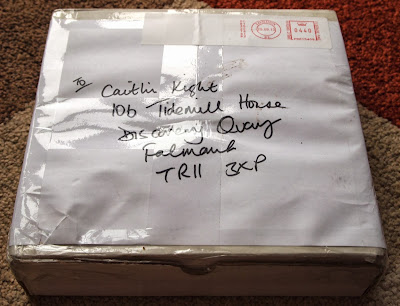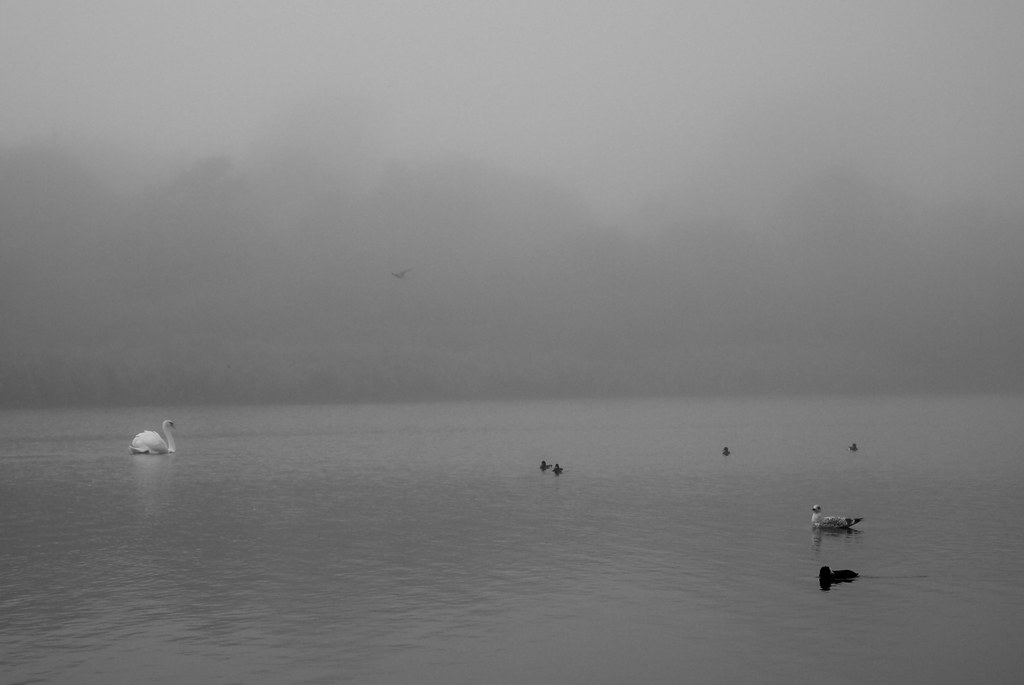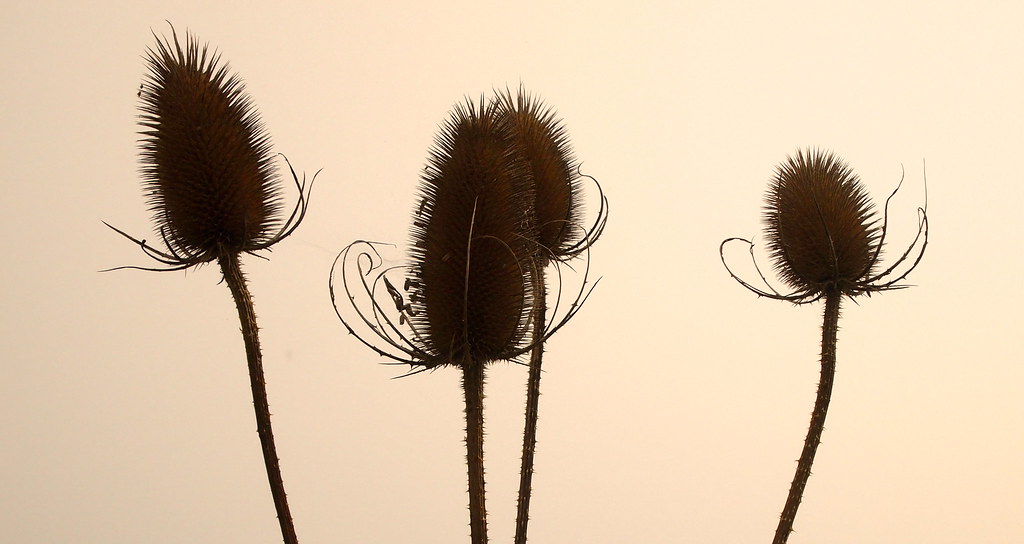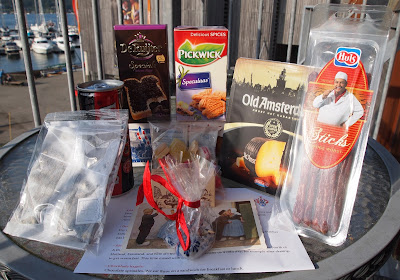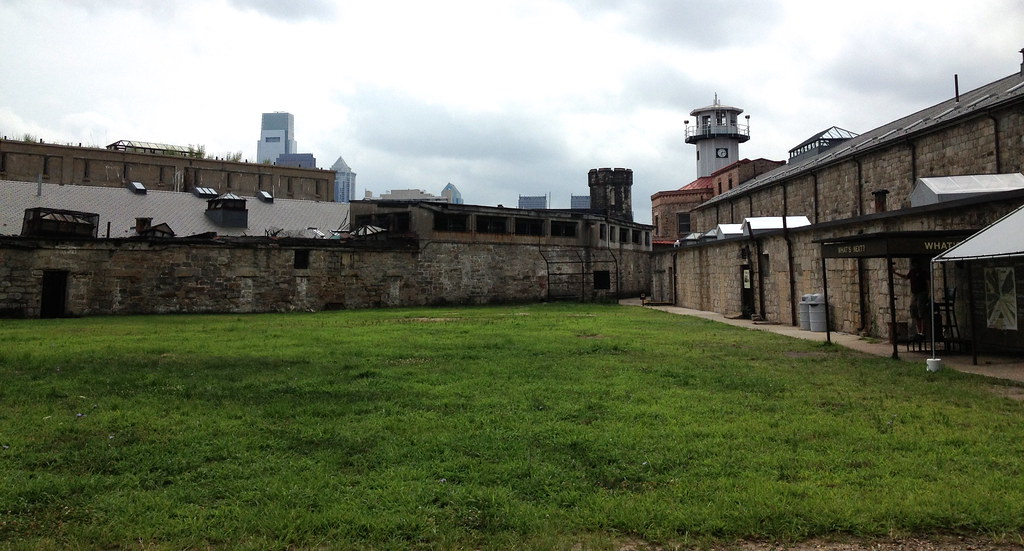The Pocahontas Files has moved to its own domain:
http://www.thepocahontasfiles.com
Be sure to visit the new site and sign up to receive new blog entries in your inbox!
Sunday 17 November 2013
Saturday 12 October 2013
Where to Eat in Falmouth: Hunky Dory
After I moved to Falmouth, one of the first restaurants I visited was Hunky Dory, which is conveniently located about a block away from Sasha's and my apartment. The restaurant used to be a favorite of the bio department, and was frequently the establishment chosen when a guest speaker or other important person needed to be treated to an upscale meal. Indeed, that is exactly why I wound up there many years ago: An emeritus professor had come back to visit the campus, and there was a large dinner party held in his honor. Since then, I've only visited Hunky Dory once--not because there is anything wrong with it, but because so many other great restaurants have opened in the last couple of years and enticed us away from the older venues. This week, however, Sasha and I revisited HD and reminded ourselves of what we've been missing all this time.
We wound up there a bit serendipitously; I initially tried to get us reservations at another restaurant that, sadly, was completely booked because the town is full of visitors who have come to attend the annual Falmouth Oyster Festival. Hunky Dory was merely the fall-back option, but our meals were so good that I felt a little guilty not having considered the restaurant as my first choice.
I started off with some local pressed apple juice, which was the perfect accompaniment to my baked goat cheese/apple puree/roasted chicory/date and walnut salad starter:
Sasha, who generally avoids starters in order to ensure that he has room for dessert, was forced to sit and watch me practically lick my plate clean. His only consolation was that my appetizer blended sweet and savory flavors, which, in his opinion, rendered it completely inedible.
Soon enough, he was able to enjoy his main course, which was one of the evening's specials: cod and prawns with saffron-boiled potatoes.
I tend to avoid using saffron because I have a hard time stomaching the price--especially considering that it adds much more color than it does flavor. I have to admit, though, that it does make for an impressive presentation.
Speaking of which:
This lovely tower of food is my main course, the mozzarella-stuffed saffron (again!) risotto cake, sitting atop creamed garlic spinach and a portobello mushroom. Basically, it was a giant arancini, which is fine by me; it's hard to imagine too many ways that risotto could be improved upon, but a little bit of breading and frying certainly does the trick. I liked having the veggies there to add some lightness and freshness to counteract the heaviness of the cream and cheese. Delicious.
As per usual, I was too full to indulge in a dessert, but Sasha had the (vanilla) panna cotta, which came with a fruit puree, a scoop of ice cream, and a shortbread cookie:
We also toasted the evening with some glasses of port, as tends to be our routine these days. I aspire to be able to drink one of these without having it immediately go to my head. Sadly, I'm not there quite yet; obviously I will need to do a bit more training.
In addition to very much enjoying our food, Sasha and I were also quite impressed with how attentive and friendly all the waitstaff were (including one who is also a PhD student in our department!). They acted as though we were favorite customers who visit on a regular basis. Though that is not the case, that sort of royal treatment makes me think that maybe we should make it a point to visit Hunky Dory more often!
---
Hunky Dory can be found at 46 Arwenack Street, Falmouth.
We wound up there a bit serendipitously; I initially tried to get us reservations at another restaurant that, sadly, was completely booked because the town is full of visitors who have come to attend the annual Falmouth Oyster Festival. Hunky Dory was merely the fall-back option, but our meals were so good that I felt a little guilty not having considered the restaurant as my first choice.
I started off with some local pressed apple juice, which was the perfect accompaniment to my baked goat cheese/apple puree/roasted chicory/date and walnut salad starter:
Sasha, who generally avoids starters in order to ensure that he has room for dessert, was forced to sit and watch me practically lick my plate clean. His only consolation was that my appetizer blended sweet and savory flavors, which, in his opinion, rendered it completely inedible.
Soon enough, he was able to enjoy his main course, which was one of the evening's specials: cod and prawns with saffron-boiled potatoes.
I tend to avoid using saffron because I have a hard time stomaching the price--especially considering that it adds much more color than it does flavor. I have to admit, though, that it does make for an impressive presentation.
Speaking of which:
This lovely tower of food is my main course, the mozzarella-stuffed saffron (again!) risotto cake, sitting atop creamed garlic spinach and a portobello mushroom. Basically, it was a giant arancini, which is fine by me; it's hard to imagine too many ways that risotto could be improved upon, but a little bit of breading and frying certainly does the trick. I liked having the veggies there to add some lightness and freshness to counteract the heaviness of the cream and cheese. Delicious.
As per usual, I was too full to indulge in a dessert, but Sasha had the (vanilla) panna cotta, which came with a fruit puree, a scoop of ice cream, and a shortbread cookie:
 |
| I may have helped Sasha eat the shortbread--but only to make sure it didn't go to waste, of course. |
In addition to very much enjoying our food, Sasha and I were also quite impressed with how attentive and friendly all the waitstaff were (including one who is also a PhD student in our department!). They acted as though we were favorite customers who visit on a regular basis. Though that is not the case, that sort of royal treatment makes me think that maybe we should make it a point to visit Hunky Dory more often!
---
Hunky Dory can be found at 46 Arwenack Street, Falmouth.
Wednesday 2 October 2013
Foodie Penpals Reveal: September 2013
This month's Foodie Penpals parcel has been sitting around since late last week, just waiting to be opened. I've been so busy settling in to my new job that I have been lax about staying on top of other activities, such as blogging or peeking into packages related to blogs.
However, my curiosity finally overcame my feeling of being harried, and I set aside a few minutes to see what this month's penpal, Amanda Mercer, had sent my way. Amanda was kind enough to step into the breach after my first penpal failed to get in touch at the beginning of the month; with only a few days to spare before the shipment deadline, she put together this very decadent parcel so that I wouldn't be left in the unenviable position of sending, but not receiving, a penpal package.
As I have discovered from subsequent e-mails with Amanda, she is someone who appreciates the value of a good snack stash at work. I am not surprised about that, because many of her choices are exactly what you need to eat at 3 PM so that you have the energy and willpower to make it through the rest of the afternoon. As evidence, I offer Exhibit A:
The sweeter components of the parcel, shown above, included some biscuits, two different types of chocolate bar (for when I am feeling particularly indulgent), and some homemade flapjacks. Flapjacks are a thing I had never heard of until I moved to Britain; I quickly became a huge fan, because they are chewy and tasty and filling, all at the same time.
Also included were savory items and cooking ingredients: toasted edamame (which I've never yet tried but which I assume I will enjoy since I like corn, peas, and garbanzo beans prepared in the same way), a bag of assorted teas, and two packets of Thai-themed flavors (aromatic Thai seasoning mix, and coconut milk in powder form--something that I didn't even know existed until today). There were also some piping bags, which are shown in the next photo:
Obviously, I will need to have a hearty snack at work, cook up a Thai dinner, and then finish it all off with a cup of tea and a dessert that features some piped icing. Sounds good to me!
However, my curiosity finally overcame my feeling of being harried, and I set aside a few minutes to see what this month's penpal, Amanda Mercer, had sent my way. Amanda was kind enough to step into the breach after my first penpal failed to get in touch at the beginning of the month; with only a few days to spare before the shipment deadline, she put together this very decadent parcel so that I wouldn't be left in the unenviable position of sending, but not receiving, a penpal package.
As I have discovered from subsequent e-mails with Amanda, she is someone who appreciates the value of a good snack stash at work. I am not surprised about that, because many of her choices are exactly what you need to eat at 3 PM so that you have the energy and willpower to make it through the rest of the afternoon. As evidence, I offer Exhibit A:
The sweeter components of the parcel, shown above, included some biscuits, two different types of chocolate bar (for when I am feeling particularly indulgent), and some homemade flapjacks. Flapjacks are a thing I had never heard of until I moved to Britain; I quickly became a huge fan, because they are chewy and tasty and filling, all at the same time.
Also included were savory items and cooking ingredients: toasted edamame (which I've never yet tried but which I assume I will enjoy since I like corn, peas, and garbanzo beans prepared in the same way), a bag of assorted teas, and two packets of Thai-themed flavors (aromatic Thai seasoning mix, and coconut milk in powder form--something that I didn't even know existed until today). There were also some piping bags, which are shown in the next photo:
Obviously, I will need to have a hearty snack at work, cook up a Thai dinner, and then finish it all off with a cup of tea and a dessert that features some piped icing. Sounds good to me!
Sunday 22 September 2013
Foggy first day of fall in Falmouth
Although today is officially the first day of fall--or "autumn," as they prefer to say here in the UK--I have felt it coming for a while. We've actually had fairly summery weather the last few weeks, but the changing day length is an unmistakeable sign that we are headed towards the cold, dark portion of the year.
As a result, I've been feeling a bit antsy, like a migratory bird becoming restless in the days before it heads south. I don't feel the urge to go anywhere (though if you told me you wanted to send me to the Maldives for a week, I wouldn't complain). I do, however, feel the same inclinations that I feel every autumn, to do things that haven't been a part of my routine for years. I want to go back-to-school shopping for clothes and office supplies; I want to put on a sweater and go watch a football game under stadium lights; I want to meet up with my cross country team and race on a 5K course that smells like damp earth and fallen leaves. Most especially, I want to eat candy corn.
Those things were a part of my life for so long that it is hard to shake the feeling that I should still be doing them, even after all these years. When I lived in the US, I could see them happening around me, so I could vicariously get my fix of autumn activities. Things are quite different here in the UK, though. Sports are different, weather patterns are different, food is different. For example, in addition to the dearth of candy corn (alas!), there is also no hint of pumpkins or pumpkin-flavored things, which I also associate with fall. People don't decorate with dried corn husks or those cute miniature gourds, and stores don't have displays of homecoming dresses or miniature candies for Halloween.
On any given day, if you asked me to describe myself, "small-town girl," "Midwesterner," and "American" wouldn't be high on my list. In autumn, though, the drifting of my thoughts reminds me that I am most definitely all three of those things, no matter where I go or what I do. The fall-themed movie that plays in my mind contains just about every American cliche you can think of, from pickup trucks driving down windy country roads, to plaid flannel-wearing men going hunting, to V's of Canada geese flying above red, yellow, and orange trees. I can practically smell the smoke from the fires my grandparents light in their wood stove, and almost taste the winesap apples my dad faithfully brings home from the farmer's market throughout the harvest season.
I don't necessarily feel sad about missing out on all these quintessential American activities, but I suppose that I do feel a bit of wistful nostalgia--not so much about the US in general as about my childhood there. The return to school each autumn heralded the chance to make new friends (and, of course, boyfriends), learn new things, be a different person than I had been when school let out at the start of summer. All these possibilities made me think of fall as quite an exciting season, and I still feel the remnants of that excitement even now. Those positive vibes more than made up for the fact that autumn can actually be quite depressing, what with the plants shutting down and the animals departing and going into hibernation.
As far as I can remember, I have only ever been homesick once in my life--an autumn night during my freshman year in college. I had my window cracked open and could smell that sweet, earthy scent of decaying leaves; every now and then, the sound of a goose's honking voice would drift up from the pond behind my dorm room. The poignancy of the moment inspired probably the best poem I have ever written, and I can still picture that scene vividly. I find it interesting that I am still, consistently, contemplative at this time of year.
None of this is to say that Britain doesn't have any charm once September rolls around. In our part of the country, at least, we can look forward to temperatures that are cooler but never very cold; as a result, we often get dramatic fog under conditions that are comfortable enough to allow pleasant walks. This was certainly the case this weekend, which was both the last of summer and the first of fall. Though the town has been swathed in thick mist since early this morning (and soundtracked by the consistent tolling of the foghorn out in the bay), the coastal path was full of people enjoying the dramatic views--or lack thereof. Like me, they were obeying the urge to flock to the shore to see what couldn't be seen.
It all felt very deep and metaphorical, and I could see more than one set of eyes filled with a far-off look. Maybe I'm being melodramatic because of my own contemplative frame of mind, but it seemed that everyone was pausing, thinking, and remembering. I think that's just the nature of the season: The beach trips are behind you and the merriment of Christmas is too far ahead of you to seem concrete, and so you are left in a bit of a hinterland. It's disconcerting, but also fascinating. It reminds me of how it feels to travel to a foreign country: Only when you're unmoored and working without a safety net (excuse the mixed metaphors) do you learn whether or not you can make it on your own. It's a bit risky, a bit scary, but also somewhat thrilling.
I guess that means autumn still offers me a feeling of excitement and opportunity, just like it did when I was young. I won't be running any cross country races or attending any homecoming dances (probably both for the best), but I'm sure there are other adventures waiting. I just need to go see what's on offer. (Too bad it's not candy corn.)
As a result, I've been feeling a bit antsy, like a migratory bird becoming restless in the days before it heads south. I don't feel the urge to go anywhere (though if you told me you wanted to send me to the Maldives for a week, I wouldn't complain). I do, however, feel the same inclinations that I feel every autumn, to do things that haven't been a part of my routine for years. I want to go back-to-school shopping for clothes and office supplies; I want to put on a sweater and go watch a football game under stadium lights; I want to meet up with my cross country team and race on a 5K course that smells like damp earth and fallen leaves. Most especially, I want to eat candy corn.
Those things were a part of my life for so long that it is hard to shake the feeling that I should still be doing them, even after all these years. When I lived in the US, I could see them happening around me, so I could vicariously get my fix of autumn activities. Things are quite different here in the UK, though. Sports are different, weather patterns are different, food is different. For example, in addition to the dearth of candy corn (alas!), there is also no hint of pumpkins or pumpkin-flavored things, which I also associate with fall. People don't decorate with dried corn husks or those cute miniature gourds, and stores don't have displays of homecoming dresses or miniature candies for Halloween.
On any given day, if you asked me to describe myself, "small-town girl," "Midwesterner," and "American" wouldn't be high on my list. In autumn, though, the drifting of my thoughts reminds me that I am most definitely all three of those things, no matter where I go or what I do. The fall-themed movie that plays in my mind contains just about every American cliche you can think of, from pickup trucks driving down windy country roads, to plaid flannel-wearing men going hunting, to V's of Canada geese flying above red, yellow, and orange trees. I can practically smell the smoke from the fires my grandparents light in their wood stove, and almost taste the winesap apples my dad faithfully brings home from the farmer's market throughout the harvest season.
I don't necessarily feel sad about missing out on all these quintessential American activities, but I suppose that I do feel a bit of wistful nostalgia--not so much about the US in general as about my childhood there. The return to school each autumn heralded the chance to make new friends (and, of course, boyfriends), learn new things, be a different person than I had been when school let out at the start of summer. All these possibilities made me think of fall as quite an exciting season, and I still feel the remnants of that excitement even now. Those positive vibes more than made up for the fact that autumn can actually be quite depressing, what with the plants shutting down and the animals departing and going into hibernation.
As far as I can remember, I have only ever been homesick once in my life--an autumn night during my freshman year in college. I had my window cracked open and could smell that sweet, earthy scent of decaying leaves; every now and then, the sound of a goose's honking voice would drift up from the pond behind my dorm room. The poignancy of the moment inspired probably the best poem I have ever written, and I can still picture that scene vividly. I find it interesting that I am still, consistently, contemplative at this time of year.
None of this is to say that Britain doesn't have any charm once September rolls around. In our part of the country, at least, we can look forward to temperatures that are cooler but never very cold; as a result, we often get dramatic fog under conditions that are comfortable enough to allow pleasant walks. This was certainly the case this weekend, which was both the last of summer and the first of fall. Though the town has been swathed in thick mist since early this morning (and soundtracked by the consistent tolling of the foghorn out in the bay), the coastal path was full of people enjoying the dramatic views--or lack thereof. Like me, they were obeying the urge to flock to the shore to see what couldn't be seen.
It all felt very deep and metaphorical, and I could see more than one set of eyes filled with a far-off look. Maybe I'm being melodramatic because of my own contemplative frame of mind, but it seemed that everyone was pausing, thinking, and remembering. I think that's just the nature of the season: The beach trips are behind you and the merriment of Christmas is too far ahead of you to seem concrete, and so you are left in a bit of a hinterland. It's disconcerting, but also fascinating. It reminds me of how it feels to travel to a foreign country: Only when you're unmoored and working without a safety net (excuse the mixed metaphors) do you learn whether or not you can make it on your own. It's a bit risky, a bit scary, but also somewhat thrilling.
I guess that means autumn still offers me a feeling of excitement and opportunity, just like it did when I was young. I won't be running any cross country races or attending any homecoming dances (probably both for the best), but I'm sure there are other adventures waiting. I just need to go see what's on offer. (Too bad it's not candy corn.)
Friday 30 August 2013
Foodie Penpals: August Reveal
This month's Foodie Penpal parcel is brought to you courtesy of the amazing sunshine that we have been having here in Cornwall this summer. I didn't need to take photographs of the package out on our balcony, but it was too pleasant outside not to.
The parcel was put together by Saskia Jager of The Netherlands. I've now had several penpals from Holland, and I am amazed by how different each of their parcels has been (though all have involved sausage--the Dutch must really love sausage). I believe that Saskia is my first penpal from the Friesland area, which is on Holland's northern coast.
Saskia included both a handwritten note on a postcard and a lengthier typed message describing each of the items in the package and, where necessary, providing some explanation of how things should be eaten.
You might think that food is pretty straightforward and doesn't require any explanation, but actually I needed some help right away, with the De Ruijter Specials. I would have thought these were for decorating cupcakes or other sweet baked goods, but evidently they are for adding a bit of flavor to toast at breakfast or lunch. I haven't opened the package yet, but judging from the picture on the front, the Specials are basically chocolate sprinkles (or hundreds and thousands, as the British would say). How interesting. I will have to whip these out one morning when I hear my sweet tooth calling.
The Fryske Dumkes ('Friesland thumbs') are little anise-flavored biscuits, and they are lovely. I've been having a couple with my tea every night after dinner. I will be sad when the package is empty, but I suspect that I could hunt down a recipe and replicate these myself. The red, white, and blue heart pattern on the box is derived from the Friesland flag, which features seven little red hearts representing the old Friesian countries (or, at least, so says Wikipedia).
Also utterly delicious were the droge worst and Old Amsterdam cheese. I admit, I was a bit hungry when I opened the parcel, so I immediately sampled the sausage sticks...and just kept on going until they were done. They were so good that I got online and ordered several more packs from a Dutch shop. The entire website was in Dutch, and I kept copying the text and pasting it into Google Translate so I could figure out what was going on. Fingers crossed I actually ordered what I think I ordered, and that I sent it to the correct address!
The Old Amsterdam cheese is kind of like a cross between cheddar and Edam, only a bit harder and drier than both--more the texture of Parmesan. It is very tasty, and good with both savory things like crackers, and sweet things like fruit. Cheese is the main reason why I will never have six-pack abs, but when it tastes as good as this stuff does, it's totally worth the swap.
Saskia also included several potables. There was a box of Pickwick brand speculaas-flavored tea that basically tasted like Christmas in a cup. Speculaas are popular Dutch biscuits (I've received them before in previous Foodie Penpal parcels, and boy are they addictive), and Pickwick is the same brand that made the amazing caramelized pear tea that I received a couple months ago. So, right off the bat, I knew that this stuff would be good.
There was also a giant teabag meant to be brewed not in a cup or pot, but in a bathtub; it contains herbs that are supposed to help me relax. I'm saving that for when I'm feeling particularly stressed and need a bit of home spa treatment.
The last beverage is a pre-mixed alcoholic drink called Sonnema Cola. According to the company's website, Sonnema is a spicy drink that goes well with Coke because it is a "delicious combination of gin, herbs, and citrus." You are supposed to serve it with a slice of lemon, and although the website says it is good for drinking at the pub or disco, Saskia also mentioned that people often drink these cocktails when they've come in from the cold--after a day of skiing, for example.
As though all that weren't enough, the parcel also contained a little bag of hard candies, a small chocolate bar shaped like a peat brick (because it comes from a peat-harvesting region), and a pair of tiny ceramic clogs. Obviously the clogs aren't for eating, but my goodness are they adorable. (They've also inspired me to include a similar Cornish trinket in some of my future Foodie Penpal packages...)
Although I've still never been to Holland (outside the Amsterdam airport, that is), all my experience with Dutch food is beginning to make me feel as though I know something about the country. My FP parcels are no substitute for an actual trip to The Netherlands, but for now they will do the trick. Thanks very much to Saskia for giving me a glimpse and a taste of Friesland!
The parcel was put together by Saskia Jager of The Netherlands. I've now had several penpals from Holland, and I am amazed by how different each of their parcels has been (though all have involved sausage--the Dutch must really love sausage). I believe that Saskia is my first penpal from the Friesland area, which is on Holland's northern coast.
Saskia included both a handwritten note on a postcard and a lengthier typed message describing each of the items in the package and, where necessary, providing some explanation of how things should be eaten.
You might think that food is pretty straightforward and doesn't require any explanation, but actually I needed some help right away, with the De Ruijter Specials. I would have thought these were for decorating cupcakes or other sweet baked goods, but evidently they are for adding a bit of flavor to toast at breakfast or lunch. I haven't opened the package yet, but judging from the picture on the front, the Specials are basically chocolate sprinkles (or hundreds and thousands, as the British would say). How interesting. I will have to whip these out one morning when I hear my sweet tooth calling.
The Fryske Dumkes ('Friesland thumbs') are little anise-flavored biscuits, and they are lovely. I've been having a couple with my tea every night after dinner. I will be sad when the package is empty, but I suspect that I could hunt down a recipe and replicate these myself. The red, white, and blue heart pattern on the box is derived from the Friesland flag, which features seven little red hearts representing the old Friesian countries (or, at least, so says Wikipedia).
Also utterly delicious were the droge worst and Old Amsterdam cheese. I admit, I was a bit hungry when I opened the parcel, so I immediately sampled the sausage sticks...and just kept on going until they were done. They were so good that I got online and ordered several more packs from a Dutch shop. The entire website was in Dutch, and I kept copying the text and pasting it into Google Translate so I could figure out what was going on. Fingers crossed I actually ordered what I think I ordered, and that I sent it to the correct address!
The Old Amsterdam cheese is kind of like a cross between cheddar and Edam, only a bit harder and drier than both--more the texture of Parmesan. It is very tasty, and good with both savory things like crackers, and sweet things like fruit. Cheese is the main reason why I will never have six-pack abs, but when it tastes as good as this stuff does, it's totally worth the swap.
Saskia also included several potables. There was a box of Pickwick brand speculaas-flavored tea that basically tasted like Christmas in a cup. Speculaas are popular Dutch biscuits (I've received them before in previous Foodie Penpal parcels, and boy are they addictive), and Pickwick is the same brand that made the amazing caramelized pear tea that I received a couple months ago. So, right off the bat, I knew that this stuff would be good.
There was also a giant teabag meant to be brewed not in a cup or pot, but in a bathtub; it contains herbs that are supposed to help me relax. I'm saving that for when I'm feeling particularly stressed and need a bit of home spa treatment.
The last beverage is a pre-mixed alcoholic drink called Sonnema Cola. According to the company's website, Sonnema is a spicy drink that goes well with Coke because it is a "delicious combination of gin, herbs, and citrus." You are supposed to serve it with a slice of lemon, and although the website says it is good for drinking at the pub or disco, Saskia also mentioned that people often drink these cocktails when they've come in from the cold--after a day of skiing, for example.
As though all that weren't enough, the parcel also contained a little bag of hard candies, a small chocolate bar shaped like a peat brick (because it comes from a peat-harvesting region), and a pair of tiny ceramic clogs. Obviously the clogs aren't for eating, but my goodness are they adorable. (They've also inspired me to include a similar Cornish trinket in some of my future Foodie Penpal packages...)
Although I've still never been to Holland (outside the Amsterdam airport, that is), all my experience with Dutch food is beginning to make me feel as though I know something about the country. My FP parcels are no substitute for an actual trip to The Netherlands, but for now they will do the trick. Thanks very much to Saskia for giving me a glimpse and a taste of Friesland!
Sunday 25 August 2013
Where to Eat in Falmouth: Samphire
Samphire has long been my favorite restaurant in Falmouth, so I can't believe it's taken me this long to review one of my meals there. It's true that I have also sung the praises of Oliver's (which is a wonderful place, make no mistake), but Samphire has a special place in my heart because it is so close to our apartment and has been the site of many a delicious meal. Sasha and I recently visited the restaurant to celebrate our fifth anniversary--not our fifth wedding anniversary, but the fifth anniversary of our first date, which happened to also involve a nice dinner out. What can I say? We like food.
For this particular occasion, my appetizer consisted of wild mushroom bruschetta served with sorrel pesto, a cheese panna cotta, and kind of a hard candy made from caramelized red onion. I never can resist mushrooms, but in this case I was particularly intrigued by the concept of cheese creme brulee. The whole thing was tremendously tasty, and as I ate the last bite I couldn't help but wish that I could have ordered a giant version of the dish to have as my meal.
Luckily, my main course was also delicious, so I didn't feel sorry for myself for too long. I ordered the hake with a spicy lentil dahl and coriander dressing. Normally I pick off fish skin, even when it is golden and crunchy like the one shown in the photo above, but in this case I just couldn't bring myself to waste something that had been so beautifully prepared. Hake is one of my favorite fish (an opinion I formed after moving to Falmouth and experiencing a huge range of fish I had never tasted, or sometimes even heard of, before), and this was a lovely version of it.
It was no surprise to me that Sasha ordered the surf-and-turf, since that is a dish that consistently attracts his attention. The steak came with a peppercorn sauce and half a locally caught lobster. He was also brought some potatoes and cooked veggies, the latter of which I helped him eat.
Because I'd filled up on carrots and cauliflower florets, I didn't really have much room for dessert. However, it was a special evening, so in the spirit of celebration I ordered a single scoop of raspberry ice cream (much to the incredulity and amusement of our server). If I hadn't been stuffed, I would very much have enjoyed an entire bowlful. Another day.
---
Samphire can be found at 36 Arwenack Street, Falmouth, UK.
For this particular occasion, my appetizer consisted of wild mushroom bruschetta served with sorrel pesto, a cheese panna cotta, and kind of a hard candy made from caramelized red onion. I never can resist mushrooms, but in this case I was particularly intrigued by the concept of cheese creme brulee. The whole thing was tremendously tasty, and as I ate the last bite I couldn't help but wish that I could have ordered a giant version of the dish to have as my meal.
Luckily, my main course was also delicious, so I didn't feel sorry for myself for too long. I ordered the hake with a spicy lentil dahl and coriander dressing. Normally I pick off fish skin, even when it is golden and crunchy like the one shown in the photo above, but in this case I just couldn't bring myself to waste something that had been so beautifully prepared. Hake is one of my favorite fish (an opinion I formed after moving to Falmouth and experiencing a huge range of fish I had never tasted, or sometimes even heard of, before), and this was a lovely version of it.
It was no surprise to me that Sasha ordered the surf-and-turf, since that is a dish that consistently attracts his attention. The steak came with a peppercorn sauce and half a locally caught lobster. He was also brought some potatoes and cooked veggies, the latter of which I helped him eat.
Because I'd filled up on carrots and cauliflower florets, I didn't really have much room for dessert. However, it was a special evening, so in the spirit of celebration I ordered a single scoop of raspberry ice cream (much to the incredulity and amusement of our server). If I hadn't been stuffed, I would very much have enjoyed an entire bowlful. Another day.
Sasha, who always has room for dessert because he doesn't eat appetizers, ordered the vanilla and yogurt panna cotta, served with thyme-poached apricots and sticky orange cake. As you can see, it was a beautiful dish, and he enjoyed it very much.
We also both ordered a glass of port so that we could toast our wood anniversary (insert joke here). Here's to five years of laughter and good food; may there be many more!
---
Samphire can be found at 36 Arwenack Street, Falmouth, UK.
Philadelphia's Eastern State Penitentiary
The last tourist stop on Sasha's and my East Coast adventure was about as conceptually far away from Longwood Gardens as you could possibly get, though it featured alongside the botanical site on Philadelphia's list of favorite attractions. It was one of the more unusual places I've ever visited on a vacation, but also one of the more unique and fascinating. It was the Eastern State Penitentiary.
Prior to heading to the penitentiary, we told a few people about our plans, and the response was always the same: Why go there? Partly it was because of the site's inclusion on the city's must-see list (attraction #18 on the Visit Philly website), and partly it was because I thought I might be able to get some interesting photos there. Above all else, though, I was interested in doing something new and different; I've been in many historical and run-down buildings--castles, churches, asylums, and homes, to name but a few--but I've never been in a penitentiary, either new or old.
Until Sasha and I began our tour, neither of us realized the historical significance of Eastern State Penitentiary (ESP)--not only to Philadelphia, but to the US and the rest of the world. It was hugely influential in shaping an entire era (beginning in 1829) of penal reform--one focused not so much on punishing criminals, but on helping them to contemplate their mistakes so that they might realize the error(s) of their ways, and use the knowledge to improve themselves.
To facilitate an appropriate level of thoughtfulness and penitence, reformers housed inmates in individual cells and forbade them to talk to each other. The cells were, predictably, quite small, and each one featured a little door leading outside to a private exercise "yard" (a glorified term for such a tiny space). During the day, inmates were expected to sit and meditate; their only diversion was a Bible and occasional visits from religious advisers and caretakers. At least, that's how it was in the beginning; later prisoners were given tools and materials for tasks such as shoe-making.
The penitentiary was quite large to begin with, but eventually grew to such a size that it was no longer feasible to enforce the strict limitations on contact between inmates; whole new wings had to be added to accommodate the expanding population, and the facility included all the sorts of places you'd find in a town--a chapel, a barbershop, a hospital and dentist, and so on.
One of the more popular portions of the tour is the cell that was inhabited by Al Capone when he was incarcerated in the prison for 8 months in 1929-1930. His stay at ESP was his first experience in jail, and, judging from the state of his cell, it probably wasn't too awful a punishment--more like staying in a very strict hotel.
Once you've completed the official tour, you are free to wander around the grounds or head back inside to spend more time in the cell blocks you've already visited. We did a little of both, allowing me to get some panoramic shots out in the yard. The site reminded me of a mixture of the Athens Asylum, a former mental institution in my hometown, and the Eastern State Hospital, one of my field work sites in Williamsburg, Virginia. It's weird to say that I felt "at home" at a jail, but there was a sense of familiarity and comfort thanks to my previous experience in those similar places.
We wandered around for something like 1-2 hours, so I think we definitely got our $14 worth out of each of our tickets. Not only was the tour interesting and out of the ordinary, but it was also available on a Sunday and located within walking distance of restaurants, shopping, lodging, and other attractions. I realize that jail visits aren't everyone's idea of a good time, but I learned a lot and enjoyed myself, so I'd definitely recommend the attraction to anybody who has time to spare in the City of Brotherly Love.
 |
| Exterior of the Eastern State Penitentiary. Image courtesy of Cheap Date Philadelphia, because I was too busy trying to take atmospheric shots inside the penitentiary to think about getting any exterior views of the facility. |
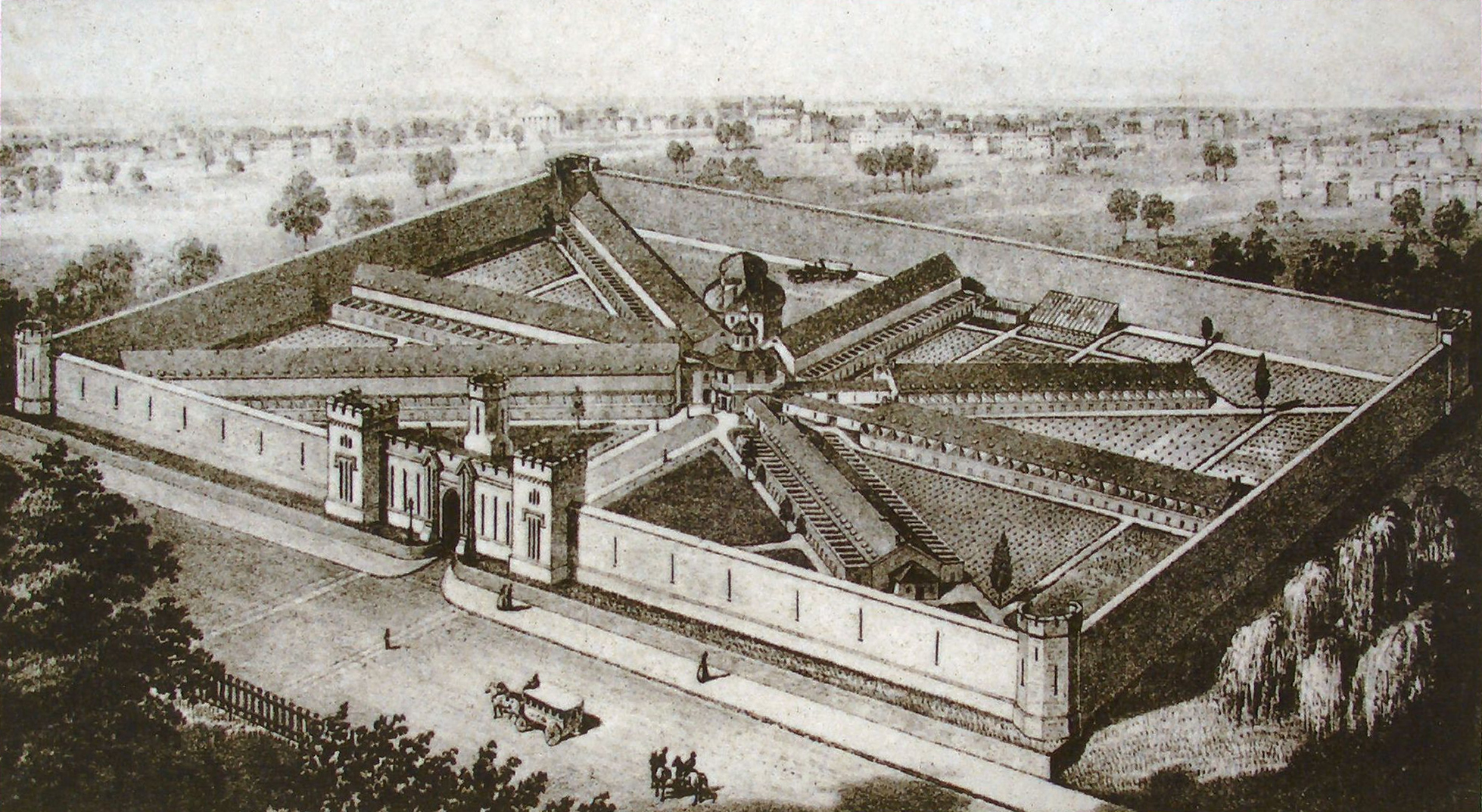 |
| Lithograph showing an aerial view of the penitentiary, 1855. Image courtesy of Wikimedia Commons. |
 |
| A typical individual cell at Eastern State Penitentiary. Image courtesy of Ideastream, which features a nice article about the benefits and drawbacks of solitary confinement. |
The penitentiary was quite large to begin with, but eventually grew to such a size that it was no longer feasible to enforce the strict limitations on contact between inmates; whole new wings had to be added to accommodate the expanding population, and the facility included all the sorts of places you'd find in a town--a chapel, a barbershop, a hospital and dentist, and so on.
 |
| Hallway where the interior portion of the audio tour begins |
We learned these facts and more by taking an audio tour (included in the price of admission) around the facility. Amazingly, the tour is narrated by Steve Buscemi, who evidently visited the penitentiary to see whether it might be a good place to film. There are approximately a dozen or so "listening points" associated with the main tour, but you can also select a couple dozen extra recordings to hear details about issues that are a bit tangential to the main narrative (e.g., jailhouse hauntings). These recordings feature the voices of people who are experts on the topics they discuss, which adds some variety to the tour.
The penitentiary is a massive facility, and only a portion of it is open for touring. The public areas have, to some extent, been cleaned and fixed up so as to be safe for visitors, but the whole place is still pretty rough and eerie looking. I think this adds to the appeal of the site, since it makes the place dramatic and mysterious. However, it also does make you feel a bit like you're doing a ghost tour, when in fact there is some very real and interesting history there (though there is also a haunted house in the autumn). I think the nonprofit organization that runs the penitentiary would probably love to fix up more of the facility, and/or to do a more extensive renovation of the bits that are already visitable, but I'm guessing the funding is just not available. When we were there, we passed several signs advertising a fundraiser aiming to earn $50,000 for the preservation of murals in the chaplain's office. I'm sure that major structural changes would require quite a bit more money than that.
 |
| Unused, and unvisitable, portion of the penitentiary; I took this photo through the bars of a locked gate preventing visitor access. |
 |
| Al Capone's cushy cell. Image courtesy of About.com. |
 |
| Panoramic shot taken outside the cell blocks. Our tour occurred in the left-most building you can see in this image. |
We wandered around for something like 1-2 hours, so I think we definitely got our $14 worth out of each of our tickets. Not only was the tour interesting and out of the ordinary, but it was also available on a Sunday and located within walking distance of restaurants, shopping, lodging, and other attractions. I realize that jail visits aren't everyone's idea of a good time, but I learned a lot and enjoyed myself, so I'd definitely recommend the attraction to anybody who has time to spare in the City of Brotherly Love.
Friday 23 August 2013
Longwood Gardens: A Taste of Europe in the US
As lovely and rugged as Cornwall is, it lacks the 'wilderness' feel that you can experience in many parts of the US. I miss that unkempt lushness and always revel in it when I'm back in the States--particularly when I'm there during the summer. That is one of the reasons why Sasha and I literally took the scenic route--Skyline Drive--between Williamsburg and Montgomery Village. Even though it extended our commute by about two hours, it was lovely to see all the crags and trees and birds along the way.
 |
| The view from Bacon Hollow Overlook |
 |
| A male indigo bunting advertises/defends his territory |
Given my fondness for these sorts of wilderness environments, I suppose it was a bit odd for me to suggest that Sasha and I stop at Longwood Gardens on our way to Philadelphia. After all, gardens tend to be rather cultivated--not to mention, we have our fair share of them here in Cornwall, so it's not as though I needed to go all the way to the US to spend time in one. Still, when I saw that the garden was listed as one of Philly's top ten attractions (despite being about 30 miles outside of town), I was intrigued. It wasn't far off our route, so why not give it a try?
 |
| Floral display near the entrance of Longwood Gardens |
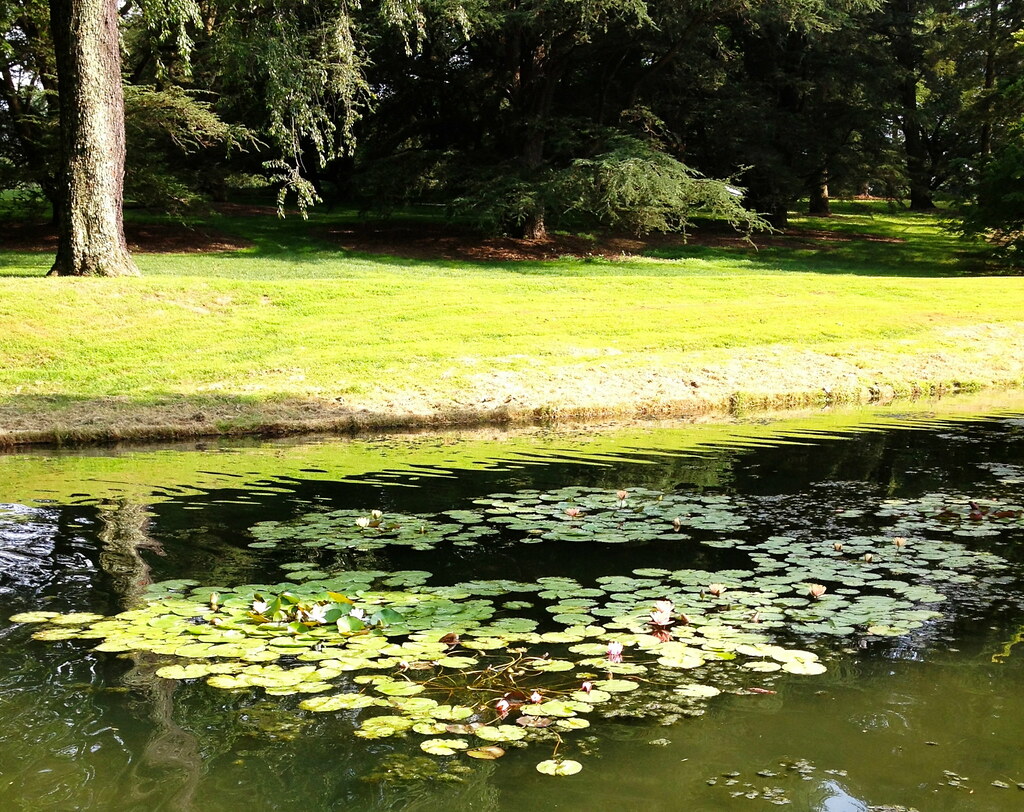 |
| Lily pads on the pond. There was also a green heron foraging on the bank, just out of frame to the left. |
The garden is located on land that was originally purchased from William Penn by the Peirce family, who went on to establish a large farm that persisted for approximately 200 years. Two of the Peirces created an arboretum on the site in 1798. The descendents of these trees were considered interesting and important enough to philanthropist Pierre du Pont that he purchased the land in 1906 in order to conserve both the plants and their habitat. He is also responsible for adding many of the more elaborate features that exist on the garden grounds today.
These include, but are not limited to, species-specific gardens (wisteria, rose, peony, etc.), a greenhouse, a waterfall, a meadow area, a woodland area, a little orchard and berry patch, and cafes and other man-made structures where you can get out of the sun and/or grab a bite to eat. At the time of our visit, one of these buildings was the headquarters for a wedding, and we caught glimpses of the party having their photographs taken amongst the foliage. Although I'm not really a white wedding type of gal (unless you're referring to the Billy Idol variety), even I can imagine that this would be a lovely place to have a ceremony and/or reception.
 |
| Sasha allowed me to take his photo outside the overrun walls of the Peirce-du-Pont House |
One of the garden features that I was most anticipating was I the "Birdhouse Treehouse," but was a bit
disappointed that there wasn't really much to see when we climbed to the
top. There were, indeed, many birdhouses, but none of them seemed to be
active during our visit; I suppose it was late in the season for that
sort of thing. We could hear a few birds singing off in the distance,
but there were no real opportunities for communing with wildlife. However, the house was full of binoculars and bird guides and even little
listening stations where you could hear recordings of the various bird
species that you are likely to observe. Assuming there are times when the boxes are occupied and the birds are a bit more visible, visitors would be well equipped to identify what they are seeing and hearing.
 |
| Treehouse offering a view of the forest and several birdboxes that had been hung therein |
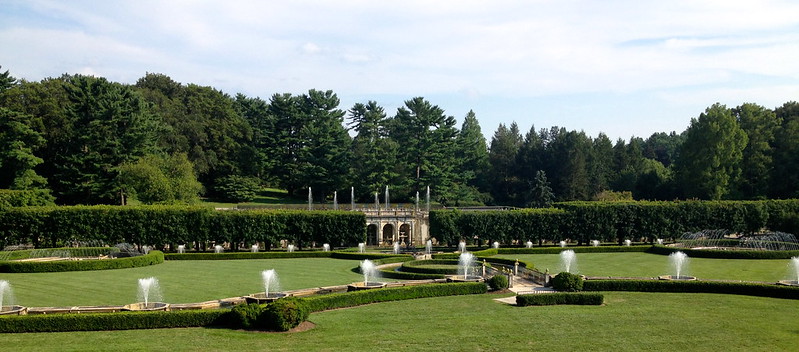
The two of us made a big loop around the outside of the garden, and one of the last major sights that we came to during our wanderings was the Chimes Tower and associated water features. The tower houses a 62-bell carillon, which was silent at the time of our visit. It overlooks a reservoir of water that flows down from the Eye of Water on the hilltop above.
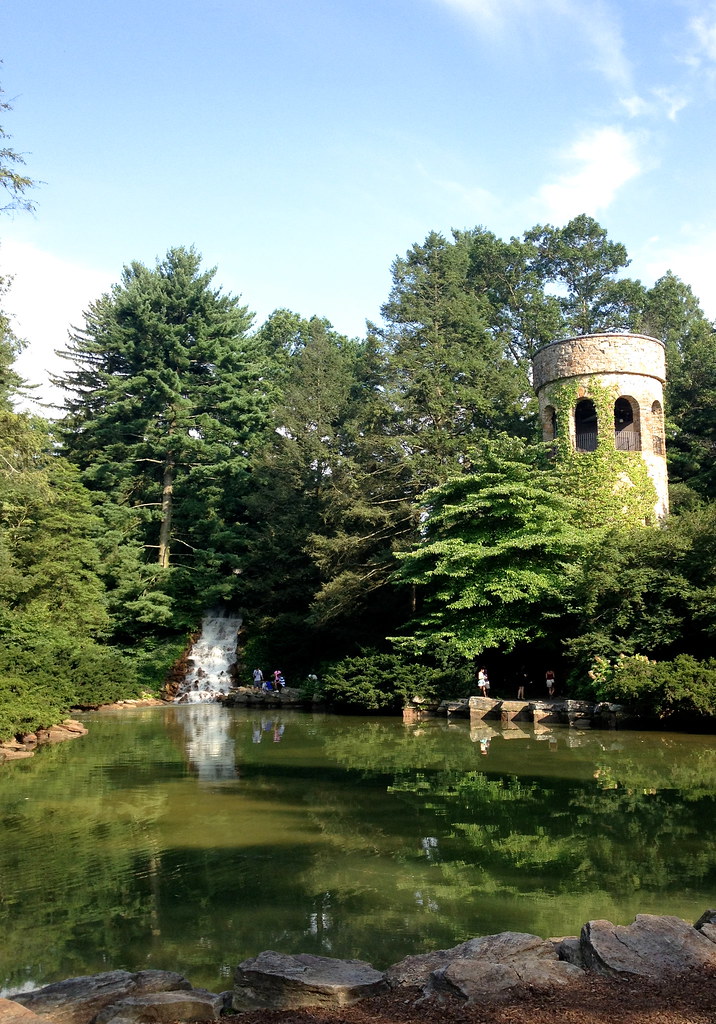 |
| The Chimes Tower, built in 1929 predominantly from stone unearthed on the land where the garden is found today. |
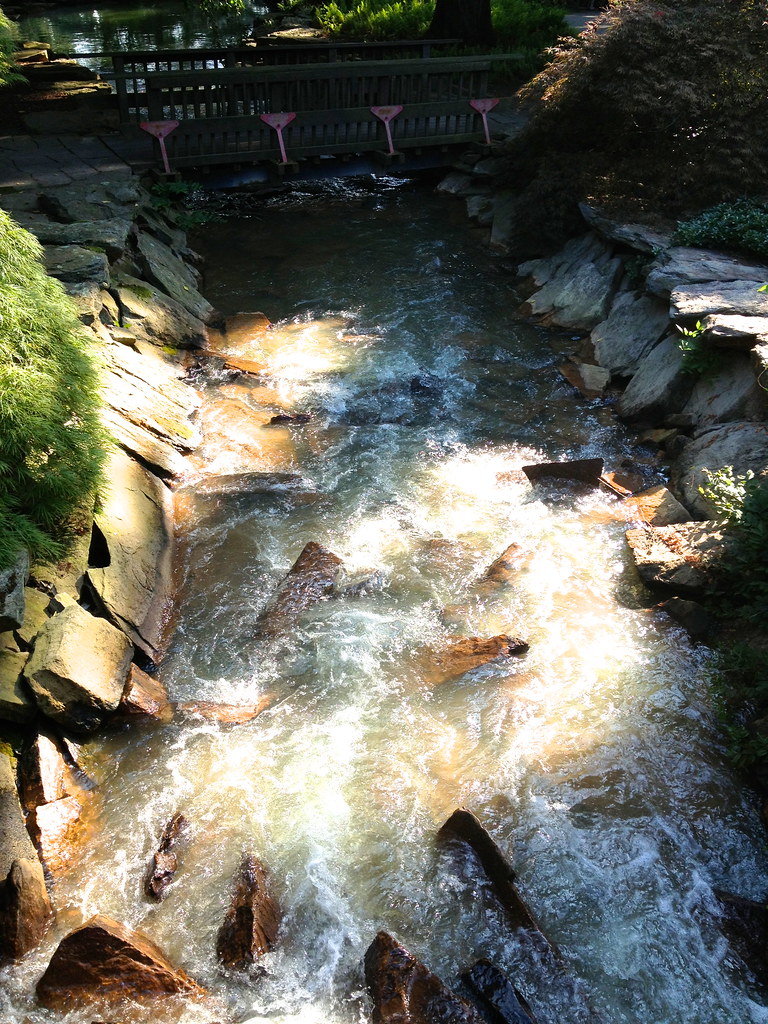 |
| The stream meandering away from the Eye of Water and down to the 50-foot waterfall that creates the reservoir at the foot of the Chimes Tower |
The "Eye of Water" sounds like something out of a fantasy, but actually it is nothing exceptionally exciting. To be honest, I found it a bit weird. The photo of the Eye on the Gardens' website is much more attractive and appealing, and suggests that perhaps the feature is merely in need of an end-of-season wash. Still, there is something disturbing about the idea of a giant eye gushing water; it is more painful than poetic. I did, however, appreciate the pagoda-like structure in which it was housed.
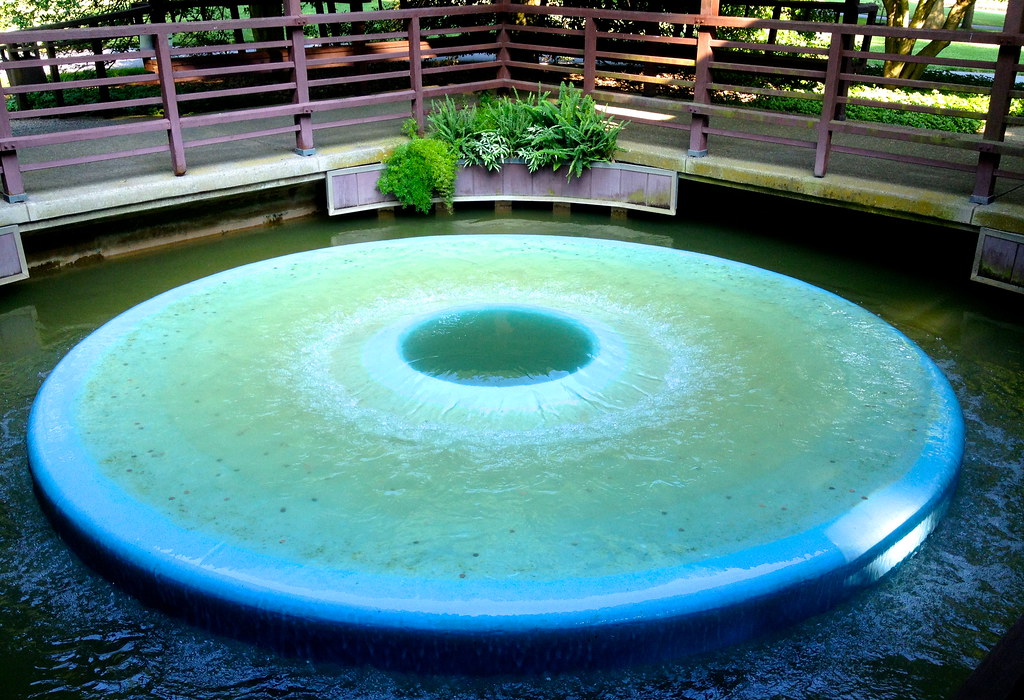 |
| The underwhelming Eye of Water |
 |
| The aptly-named elephant's-ear |
---
Longwood Gardens can be found at 1001 Longwood Road, Kennett Square, PA, 19348.
Wednesday 21 August 2013
The Baltimore National Aquarium...and other MD wildlife
My in-laws' house in Maryland was the fifth destination of my recent trip, and, as Sasha and I discovered upon our arrival, Frank and Carmen really know how to welcome someone to their home. Some people roll out the red carpet; my in-laws cultivate a nest of barn swallows:
Sasha and I normally don't do many touristy activities when we're visiting the US, but this time around we were adventurous and headed into Baltimore to explore the National Aquarium.
I've never really spent that much time in Baltimore, though I've heard many lovely things about the improvements the city has made to its waterfront area. I don't know what it used to look like, but it was quite pleasant and bustling on the day that we were there. Amazingly, Baltimore, like my in-laws, also rolled out some baby birds in order to welcome us:
As you might expect, the aquarium featured many forms of aquatic life, but there were also a number of other types of animals. Our first destination was the Animal Planet Australia exhibit, which is designed to replicate an Australian river gorge. At the entrance, there was a replica cave painting that I immediately recognized, having shown photos of the original in my "A Brief History of Birds in Art" lecture:
The Australia exhibit was full of free-flying birds, which, of course, were very distracting to me. I wanted to get photos of every species I saw, but was continually stymied by the relatively poor lighting conditions and the speed with which the animals moved. I did manage to snag a couple of decent photos before leaving the exhibit:
After returning from Down Under, we briefly entered the arena where guests can go to watch the dolphin show. I found this too depressing for words and had to leave shortly after our arrival. It is one thing to keep captive animals that are relatively small, sedentary, and/or not in need of a great deal of mental stimulation. It is another to have cetaceans other species that are highly social, incredibly clever, and naturally inclined to roam around vast areas of space. It was heartbreaking to watch the dolphins repeatedly swim in circles around their tank--which had no topography or toys or any other form of entertainment for the animals. I really hope the dolphins spend the majority of their time elsewhere, and aren't forced to spend the bulk of their time in conditions that dull.
Much more tolerable was the exhibit on jellyfish, which are, literally, brainless. I'm guessing that these guys probably don't care where they are living, as long as there is sufficient food there.
It wasn't easy to photograph the jellies through the curved glass of their aquaria, but I think the photos do an adequate job conveying how graceful and elegant the animals looked.
After stopping for a quick cup of tea, we next went to explore the coral reef, which can be observed from multiple perspectives on multiple levels (literally, I mean--the reef sits in the middle of an atrium that is several stories high).
Reefs are notoriously hard to grow in captivity, so, like many museums and aquaria, the National Aquarium relies on artificial coral to provide the foundation for its reef habitat. The effect is pretty convincing until you get up close. None of the wildlife seem to care what their home is made of, however; they are just happy to swim around and nibble on food whenever it appears.
Nearby was a display of sea birds, including guillemots, razorbills, and puffins. Seeing these species always reminds me of our yearly field trips to the Isles of Scilly, when we see the birds in the wild just as they are beginning their migration back for the spring breeding season. The auks are so cute that it is always a delight to encounter them, though it's disturbing to see them behaving in ways that suggest they've begun to go a bit crazy from being in captivity for so long. It reminds me of the portion of Happy Feet where Mumble nearly loses his mind after being thrown in a zoo. On the up side, these are very charismatic species, and one conservationist recently wrote that puffins are so endearing that they can inspire people to become environmentalists.
After touring the North Atlantic and Pacific seas, we wandered over to the upland tropical rain forest section of the aquarium. There we found, among other things, some lovely frog species:
Sasha and my in-laws encountered many species they recognized from their own experiences in the tropics, and there was much reminiscing and even some singing of animal-themed folk songs. We also wandered through a small indoor rain forest, where we encountered a sloth and a wide variety of beautiful, brightly-colored birds. I didn't manage to get good photos of any of them, which is understandable for the fast-moving birds, but pretty inexcusable for the stationary sloth.
Although there were probably a couple more exhibits we could have visited after this one, we had to take off before we ran out of time on our parking meter. One nice thing about my in-laws' home is that we could continue to do wildlife-watching once we got there; the yard is full of birds and bugs, and the house is brimming with my father-in-law's beautiful orchids.
It is a rare thing for Sasha and me to visit Maryland at any time other than Christmas, so it was a pleasure to experience the area in the summer--and to do something other than go gift shopping. The National Aquarium is not a cheap destination ($34.95 per adult ticket), but it is definitely more peaceful, aesthetically pleasing, and educational than the mall!
 |
| This is the cutest thing you will see all day |
 |
| The Baltimore Harbor |
 |
| Obviously, the city still needs to do a tad more cleaning up of its harbor |
The Australia exhibit was full of free-flying birds, which, of course, were very distracting to me. I wanted to get photos of every species I saw, but was continually stymied by the relatively poor lighting conditions and the speed with which the animals moved. I did manage to snag a couple of decent photos before leaving the exhibit:
 |
| A galah, or rose-breasted cockatoo. Sasha and I saw many of these in the wild when we visited Australia in 2010. |
 |
| Emerald dove basking under a heat lamp |
After returning from Down Under, we briefly entered the arena where guests can go to watch the dolphin show. I found this too depressing for words and had to leave shortly after our arrival. It is one thing to keep captive animals that are relatively small, sedentary, and/or not in need of a great deal of mental stimulation. It is another to have cetaceans other species that are highly social, incredibly clever, and naturally inclined to roam around vast areas of space. It was heartbreaking to watch the dolphins repeatedly swim in circles around their tank--which had no topography or toys or any other form of entertainment for the animals. I really hope the dolphins spend the majority of their time elsewhere, and aren't forced to spend the bulk of their time in conditions that dull.
Much more tolerable was the exhibit on jellyfish, which are, literally, brainless. I'm guessing that these guys probably don't care where they are living, as long as there is sufficient food there.
It wasn't easy to photograph the jellies through the curved glass of their aquaria, but I think the photos do an adequate job conveying how graceful and elegant the animals looked.
After stopping for a quick cup of tea, we next went to explore the coral reef, which can be observed from multiple perspectives on multiple levels (literally, I mean--the reef sits in the middle of an atrium that is several stories high).
Reefs are notoriously hard to grow in captivity, so, like many museums and aquaria, the National Aquarium relies on artificial coral to provide the foundation for its reef habitat. The effect is pretty convincing until you get up close. None of the wildlife seem to care what their home is made of, however; they are just happy to swim around and nibble on food whenever it appears.
 |
| Fish like romaine lettuce. Who knew? |
Unlike corals, there are many species of habitat-forming sea life that don't appear to mind living in artificial conditions. We encountered one tank in which an anemone was the site of a standoff between a couple of resident clownfish (a.k.a. anemonefish) and a small school of cardinalfish:
 |
| A dramatic standoff between cardinalfish and anemonefish. The former are delicate and beautiful, but I imagine it is a bit threatening to have a whole group of them staring you down. |
Nearby was a display of sea birds, including guillemots, razorbills, and puffins. Seeing these species always reminds me of our yearly field trips to the Isles of Scilly, when we see the birds in the wild just as they are beginning their migration back for the spring breeding season. The auks are so cute that it is always a delight to encounter them, though it's disturbing to see them behaving in ways that suggest they've begun to go a bit crazy from being in captivity for so long. It reminds me of the portion of Happy Feet where Mumble nearly loses his mind after being thrown in a zoo. On the up side, these are very charismatic species, and one conservationist recently wrote that puffins are so endearing that they can inspire people to become environmentalists.
After touring the North Atlantic and Pacific seas, we wandered over to the upland tropical rain forest section of the aquarium. There we found, among other things, some lovely frog species:
 |
| Blue poison dart frog. It is hard to imagine that anything so tiny and beautiful could be deadly. |
 |
| Amazon milk frog |
Although there were probably a couple more exhibits we could have visited after this one, we had to take off before we ran out of time on our parking meter. One nice thing about my in-laws' home is that we could continue to do wildlife-watching once we got there; the yard is full of birds and bugs, and the house is brimming with my father-in-law's beautiful orchids.
 |
| A lepidopteran friend I made while having dinner on the deck |
 |
| Some of my father-in-law's floral children |
It is a rare thing for Sasha and me to visit Maryland at any time other than Christmas, so it was a pleasure to experience the area in the summer--and to do something other than go gift shopping. The National Aquarium is not a cheap destination ($34.95 per adult ticket), but it is definitely more peaceful, aesthetically pleasing, and educational than the mall!
Subscribe to:
Posts (Atom)





